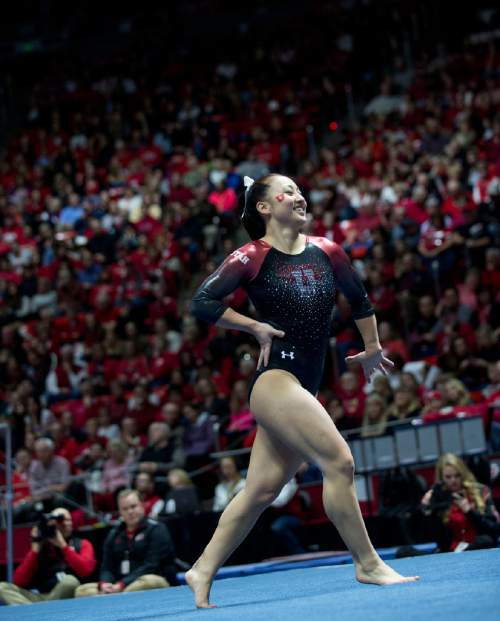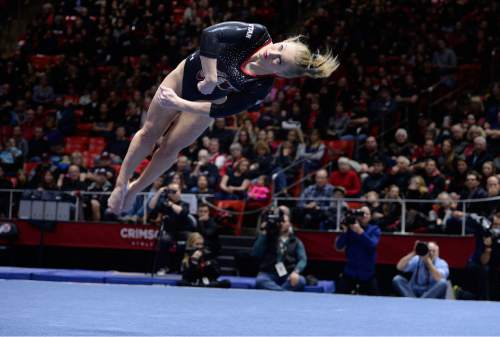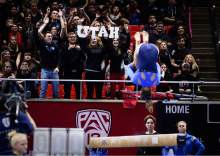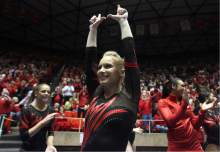This is an archived article that was published on sltrib.com in 2015, and information in the article may be outdated. It is provided only for personal research purposes and may not be reprinted.
As always, Utah gymnastics is a hot ticket at the Huntsman Center this season, with the Utes averaging 14,682 fans.
But the Utes' popularity isn't limited to Salt Lake City. It turns out Utah and other Pac-12 gymnastics teams are some of the hottest draws on the Pac-12 Network.
Even though the league doesn't release official ratings for its sports, Kirk Reynolds, the vice president of communications for the league, said gymnastics ranks behind only football and men's basketball in viewership. And it's a close third.
"Gymnastics is way up there," he said. "The really interesting thing is we see huge spikes on replays, too. It has been a remarkably strong sport for us."
The popularity has prompted the league to increase its coverage from 12 meets two years ago to 21 broadcasts this season.
Almost all of Utah's meets are being broadcast on the network, including Friday's meet at Oregon State, which begins at 8 p.m. MST.
League officials knew airing the so-called Olympic or minor sports would be crucial to filling air time and attracting a varied audience when the Pac-12 Network formed, which is why they made a commitment to show more than 500 events the first year and 850 events this season.
However, they've been pleasantly surprised at how high the ratings have been, Reynolds said.
"We are seeing a lot of sports like baseball and softball that haven't necessarily been televised in the past getting a great boost from fans," Reynolds said. "Gymnastics has been incredibly strong."
Will O'Toole, a Pac-12 producer, said he was sold on Utah gymnastics as a TV commodity after his first experience in the Huntsman Center.
"The lights go down and you've got 14,000 fans chanting and screaming and it's just an electric atmosphere," he said. "You take any men's basketball game in the nation, and you aren't going to get the kind of energy those meets have."
For Utah coach Greg Marsden, the reception doesn't come as a surprise, but is a bit of vindication for him. He has long advocated that in order to thrive, collegiate gymnastics needed to be on TV.
However, networks balked at the challenge of televising a live event that could last several hours and by fellow gymnastics coaches who don't want to eliminate teams for shorter, and thereby TV friendlier, competitions.
"It's an exciting time from my perspective," Marsden said. "What I think is going to happen is our format is going to change a lot like the way the 3-point shot or shot clock did in basketball. There were a lot of people who were against those things, but when they were implemented, you can't imagine basketball now without those. TV could be pushing us to make some changes in our sport."
The stumbling block in gymnastics is how to broadcast the national championships, which are shown on the Internet via ESPN3, with 12 teams competing. Having more than four teams in sessions means there are byes, which makes for longer meets and is harder for fans to keep track of scores.
To eliminate the need for byes, Marsden would like to cut the NCAAs from 12 to eight teams, using a format the Pac-12 championships use.
"Some coaches don't like that because they say it will be less teams at nationals, but this is the real world and it's a competition," Marsden said.
Like Marsden, O'Toole believes the time has come for gymnastics to get more exposure. Encouraged by what he has seen, O'Toole has dedicated more cameras, more bodies and more filming techniques to enhance the coverage.
"We wanted to build it up and give it the TV coverage it deserves," he said.
"It seems like the ball is rolling in all gymnastics competitions," he added. "Once people see the interest, I think changes will come, but it will come from the coaches changing their format, then TV following." —
No. 4 Utah at No. 12 Oregon St.
P Friday, 8 p.m., MST
TV • Pac-12 Network









